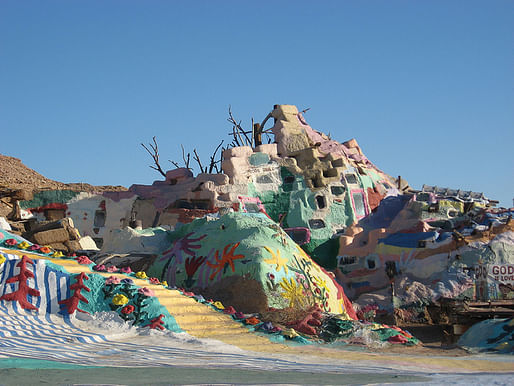

An unregulated squatter settlement, Slab City is home to perhaps 150 year-round residents — refugees from mortgages and bill collectors, former hippies, rebels and self-identified misfits — who live in personal camps made from old trailers, truck campers and crude lean-tos, and call themselves Slabbers. From October to April, the population swells to perhaps 2,000 as snowbirds, attracted by the guaranteed sunshine and zero fees, arrive in sometimes majestic motor homes. — NY Times
But now, as the New York Times article documents, the residents of Slab City are divided over the fate of their shared home. After news began to percolate that the California State Land Commission might sell the land, the "Slabbers" began to debate what to do. Should they band together to try to buy the land? Should they form a residents' association? Would that make them, for lack of a better word, sell-outs, replicating the very structures they came to Slab City to escape?

Located on top of the abandoned foundations of an old Marine base, Slab City began has been undergoing changes for some time now. After cameos in different media, in particular the film "Into the Wild," the ad-hoc city began attracting more people, some of whom are less committed to a communitarian or anarchist ethos. The Times quotes one resident: “Nowadays, a lot of people are just coming to hang out for the party.” Apparently, this has historically created problems with methamphetamine.

The article gives fair coverage to both sides of this community-driven debate. When one resident is quoted saying, "I see the necessity to have a place where people can hit rock bottom,” it's hard not to be sympathetic. And, of course, recent decades have borne witness to the rather tragic loss of alternative communities like squats and bunkhouses to forces including gentrification and corporate cooption. On the other hand, every place – in particular alternative, non-heirarchically structured ones – is subject to change. Adaptability is often the determining factor in the potential for a place or a culture to survive.
Perhaps a useful framework to consider the situation of Slab City is through the theorist Hakim Bey's influential concept, "the Temporary Autonomous Zone," or "T.A.Z." These are places that are able to evade the direct imposition of structures of control. In his original, eponymous work on the subject, Bey asserts that as soon as such a place becomes permanent, it cedes its autonomy and deteriorates into a structured system. In Deleuzian language: deterritorialization is always followed by reterritorialization. Is it possible to stave off the end of Slab City? For how long? Or, has the end already come (heralded by Kristen Stewart's brooding visage)?

After publishing his original essay, Bey would go on to work on developing theories of the "Semi-Permanent Autonomous Zone" and later "the Permanent Autonomous Zone." There may be hope for Slab City after all. Bey writes, "The more we organize this NOW the less hassle we'll have to face later. I'm not talking about 'survival' - I'm not interested in mere survival. I want to thrive."
1 Comment
I'm poor and broke and permanently disabled. Life is great free. If I met people from Slab City, I'm interested living at Slab City. Fresh water, solar power, little things air conditioning..things to be comfortable And I think that would be a great living. I wish I had a million dollars. Thanks and life isn't bad. Thanks
Block this user
Are you sure you want to block this user and hide all related comments throughout the site?
Archinect
This is your first comment on Archinect. Your comment will be visible once approved.